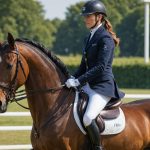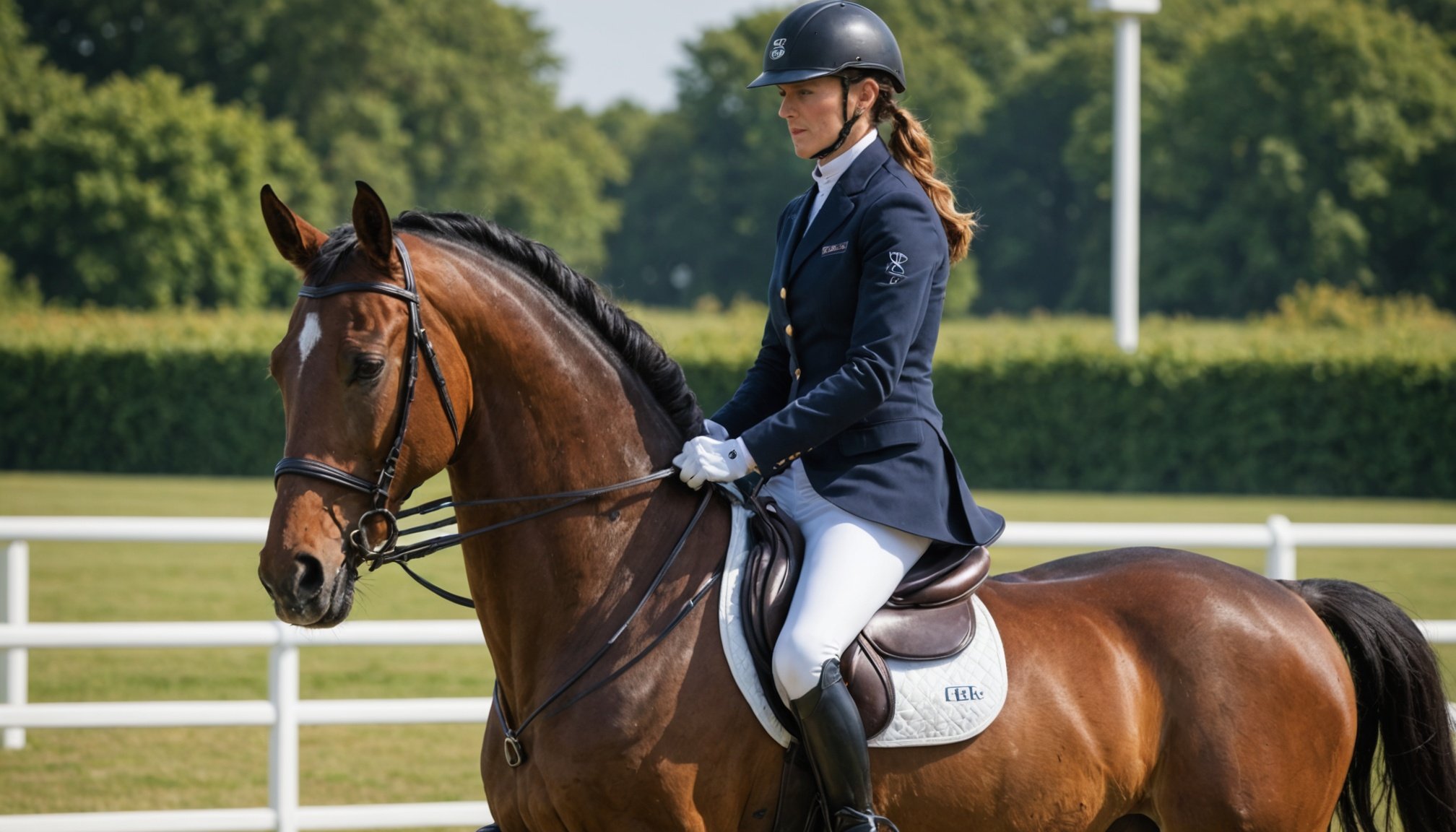Thriving Under Pressure: Essential Focus Techniques for Dressage Competitors
Dressage, often described as the ballet of equestrian sports, demands a unique blend of physical and mental prowess from both the horse and the rider. The pressure to perform flawlessly in the competition arena can be overwhelming, but there are several focus techniques that can help dressage competitors thrive under this stress.
Understanding the Pressure of Dressage Competitions
Dressage competitions are high-stakes events where every movement, every transition, and every gesture is scrutinized. The equestrian community places a significant emphasis on precision, elegance, and the harmonious partnership between the horse and the rider. This environment can be daunting, especially for young or less experienced riders.
Also to discover : Ultimate guide to preventing muscle cramps for long-distance runners during races
“It’s not just about the horse; it’s about the partnership between the horse and the rider. When you’re under pressure, it’s easy to forget that and just focus on the horse,” says Linda Keenan, secretary general of the International Dressage Trainers Club (IDTC). “But the key to success lies in maintaining that balance and understanding that the horse is not just a tool, but a partner.”
Mental Preparation: The Foundation of Success
Mental preparation is crucial for any athlete, and dressage riders are no exception. Here are some techniques that can help riders manage stress and stay focused:
Also to read : Unlocking bmx success: harnessing video analysis to boost your racing tactics
Mindfulness and Deep Breathing Exercises
Mindfulness and deep breathing exercises can significantly reduce stress and improve focus. These techniques help riders stay present in the moment, rather than getting caught up in anxiety about the future or regrets about the past.
“Mindfulness is about being fully engaged in the current moment, while cultivating a non-judgmental awareness of one’s experiences,” explains a mental health expert. “For dressage riders, this means focusing on the sensations in their body, the rhythm of the horse’s movements, and the subtle cues they need to give.”
Here’s a simple mindfulness exercise:
- Find a quiet space: Before your competition, find a quiet space where you can sit comfortably without distractions.
- Focus on your breath: Close your eyes and focus on your breath. Feel the air entering and leaving your nostrils.
- Body scan: Gradually bring your attention to different parts of your body, starting from your toes and moving up to your head, releasing any tension as you go.
- Visualize success: Imagine yourself performing perfectly in the competition. Visualize the movements, the transitions, and the applause.
Positive Reinforcement Training
Positive reinforcement training is not just beneficial for horses but also for riders. By focusing on positive reinforcement, riders can build confidence and develop a more positive mindset.
“Positive reinforcement training is about rewarding desired behavior rather than punishing undesired behavior,” notes Eva, an equine practitioner who has worked extensively with dressage horses. “For riders, this means celebrating small victories and acknowledging their hard work and progress.”
Here are some ways to incorporate positive reinforcement into your training:
- Set achievable goals: Break down your training into smaller, achievable goals. Celebrate each time you reach one of these goals.
- Use positive self-talk: Encourage yourself with positive affirmations. Instead of focusing on what went wrong, highlight what went right.
- Reward yourself: After a good training session, reward yourself with something you enjoy, like a favorite meal or a relaxing bath.
Physical Conditioning and Its Impact on Mental Health
Physical conditioning is essential for both the horse and the rider in dressage. A well-conditioned horse is more likely to perform well under pressure, and a physically fit rider can maintain focus and control throughout the competition.
Training Techniques for Physical Conditioning
Effective training techniques involve a combination of exercises that improve the horse’s responsiveness, suppleness, and understanding of aids. Here are some exercises that can help:
- Leg Yields: Leg yields are excellent for improving the horse’s suppleness and responsiveness to the rider’s aids. They involve moving the horse laterally while keeping it straight.
- Halt Transitions: Halt transitions help in developing the horse’s ability to quickly respond to the rider’s commands. They also improve the horse’s balance and self-carriage.
- Rein-Backs: Rein-backs are useful for teaching the horse to back up willingly and smoothly. This exercise helps in developing the horse’s trust in the rider and improves its overall responsiveness.
Here is a detailed table comparing different exercises and their benefits:
| Exercise | Benefits | Tips for Execution |
|---|---|---|
| Leg Yields | Improves suppleness and responsiveness | Start with small lateral movements and gradually increase the distance. |
| Halt Transitions | Develops quick response to aids, improves balance and self-carriage | Use clear and consistent aids. Ensure the horse halts squarely and promptly. |
| Rein-Backs | Develops trust and responsiveness | Start with short rein-backs and gradually increase the distance. Use gentle aids. |
Heart Rate and Physical Conditioning
Monitoring the heart rate of both the horse and the rider can provide valuable insights into their physical conditioning. Here’s how heart rate can be used:
- Horse Heart Rate: A well-conditioned horse will have a lower resting heart rate and will recover more quickly after exercise. Regular monitoring can help in adjusting the training intensity.
- Rider Heart Rate: For riders, monitoring heart rate can help in managing stress and physical exertion. High heart rates during competition can indicate stress; techniques like deep breathing can help in reducing it.
Social Media and Its Impact on Mental Health
Social media can be both a blessing and a curse for dressage competitors. While it provides a platform to share achievements and connect with the equestrian community, it can also create undue pressure and stress.
Managing Social Media Pressure
Here are some tips to manage social media pressure:
- Limit Exposure: Limit your exposure to social media, especially before competitions. Focus on your own journey rather than comparing yourself to others.
- Positive Content: Follow accounts that post positive and inspiring content. Avoid accounts that make you feel inadequate or stressed.
- Share Your Journey: Share your own journey, including the ups and downs. This can help in building a supportive community and reducing the pressure to present a perfect image.
Practical Insights and Actionable Advice
Here are some practical insights and actionable advice to help dressage competitors thrive under pressure:
Pre-Competition Routine
Develop a consistent pre-competition routine that includes both physical and mental preparation. This could involve a specific warm-up routine, mindfulness exercises, and positive self-talk.
Understanding Horse Behavior
Understanding horse behavior is crucial for effective training and performance. Recognize signs of stress or fatigue in your horse and adjust your training methods accordingly.
“Recognizing the subtle cues from your horse can make a huge difference in your performance,” advises Klaus Roeser, representing the International Dressage Riders Club (IDRC). “It’s not just about the movements; it’s about the partnership and the well-being of the horse.”
Cross Country and Dressage: A Holistic Approach
While dressage and cross country are different disciplines, they share a common goal – the well-being and performance of the horse. A holistic approach that includes both physical conditioning and mental preparation can benefit riders across various equestrian sports.
“Dressage and cross country may seem like different worlds, but the principles of good horse training remain the same,” says Sjef Janssen, a renowned dressage trainer. “It’s about treating horses like athletes and understanding their needs both physically and mentally.”
Thriving under pressure in dressage competitions requires a multifaceted approach that includes mental preparation, physical conditioning, and a deep understanding of horse behavior. By incorporating mindfulness, positive reinforcement training, and effective physical conditioning techniques, riders can improve their performance and reduce stress.
Remember, it’s not just about winning; it’s about the journey, the partnership with your horse, and the joy of riding. As you prepare for your next competition, keep these techniques in mind and focus on building a positive, supportive environment for both you and your horse.
In the world of dressage, success is not just about the rider or the horse; it’s about the harmonious partnership between them. By adopting these focus techniques, riders can ensure that they and their horses are well-prepared to thrive under the pressure of competition, leading to a more positive and rewarding experience for all involved.











